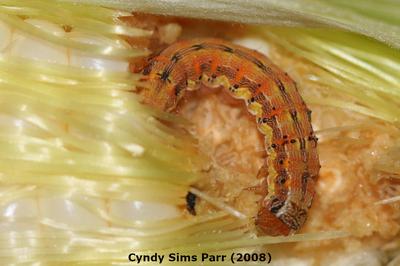Maize Earworm
Helicoverpa zea
Insect
5 mins to read
In a Nutshell
- Larvae feed on the silk hairs and then bore themselves into the ear.
- Ragged holes and a long line of frass is visible around or along the tip of the ear.
- Usually no more than one larvae is visible per cob.
- The leaves can also be affected, which creates an ideal environment for infection with other diseases.
Can also be found in
Symptoms
The maize earworm prefers the fruiting stage of the host but will also attack the foliage. Larvae feed on the silk hairs and then bore themselves into the ear, where they start to eat up the kernels. They can be seen feeding around or down the ear creating a track of damaged kernels and leaving a long line of brown frass. They are cannibalistic so usually per cob there is just one of them present. Numerous ragged holes appear at the tip of the cob and on developing leaf blades. Because they feed on floral structures and kernels and interfere with pollination and grain filling, the yield can be severely compromised. The damage creates an ideal environment for infection with other diseases.
Recommendations

Organic Control
Parasitoid Trichogramma and Telenomus wasps can help to control the population to a certain degree by infesting the eggs of Helicoverpa zea. Larval parasitoids also exist. Other beneficial insects, such as green lacewings, big-eyed bug or damsel bugs are predators of eggs and small larvae. Some beneficial nematodes also work when injected at the tip of the ear. The fungal pathogen Nomuraea rileyi and the nuclear polyhedrosis virus also reduce populations of Helicoverpa zea. Application of bio-insecticides containing Bacillus Thuringiensis or spinosad work fine if they are applied in a timely manner. Mineral oil or neem oil applied to the silk of each ear can also prevent corn earworm invasions.

Chemical Control
Use an integrated approach with preventive measures together with biological control whenever available. In the field, chemical control is rarely recommended because the larvae hide inside the cobs and are not exposed to the treatment. Insecticides containing pyrethroid, spinetoram, esfenvalerate or chlorpyrifos can be used.
What caused it?
Maize earworms overwinter as pupae in the soil, at depth of 5 to 10 cm. Robust adult moths start to emerge at the beginning of spring and are mostly active during the evening and night, more so with increasing temperatures. They have light-brown forewings, sometimes with olive shading. A wavy dark-brown band runs a few millimeters from the margins. Hindwings are white-gray and have a broad black band with a yellowish mark at the edge. Females lay white dome-shape eggs singly on fresh silk or foliage. The larvae vary in color (from pale green to reddish or brown), moderately hairy and about 3.7 mm long. They have tan or orange heads and a body covered with small black spots that correspond to microscopic spines. As they mature, two yellowish stripes develop on their flanks.
Preventive Measures
- Plant resistant or tolerant plants.
- Plant early to avoid peak populations of the moths.
- Monitor the presence of moths and mass-catch them with light or pheromone traps.
- Keep the use of insecticides to a minimum to conserve populations of beneficial insects.
- Companion cropping with plants that attract the moths might work.
- Control weeds in and around the field.
- Till the soil in-between seasons to expose the pupae to weather, birds and other predators.



